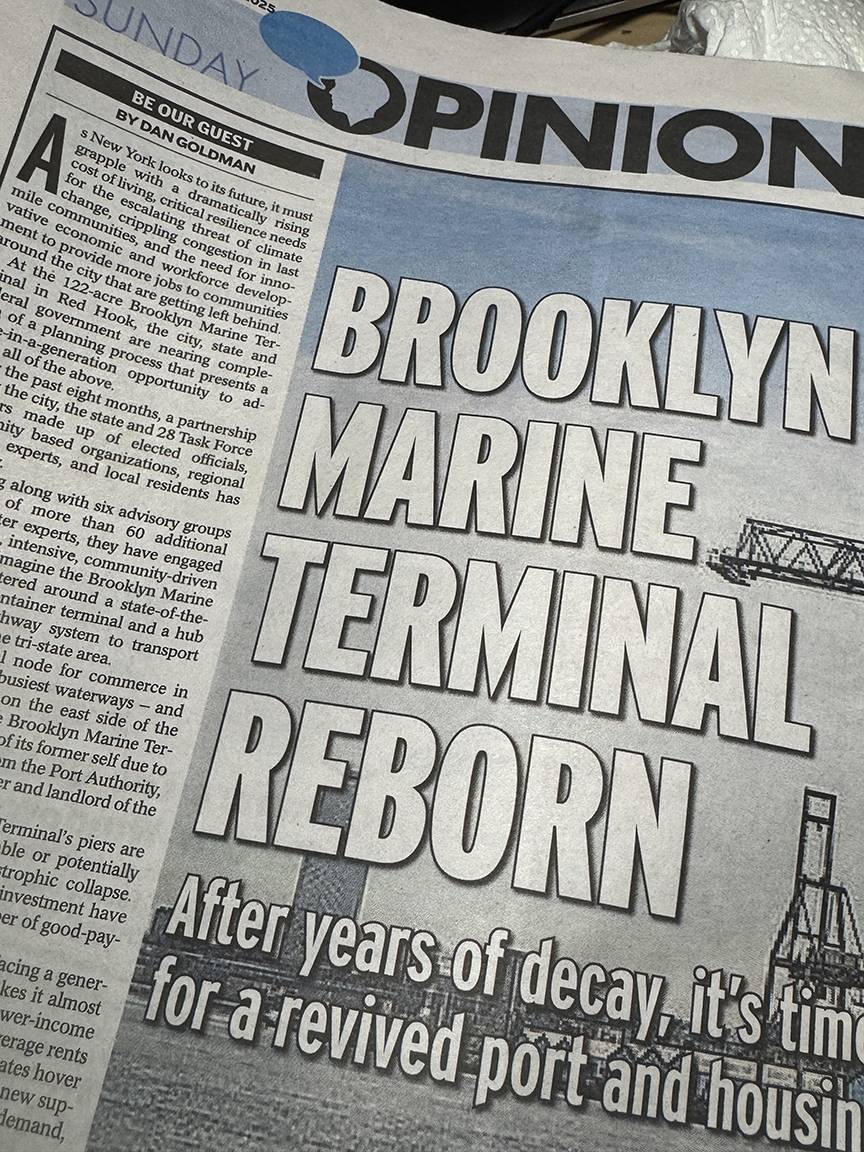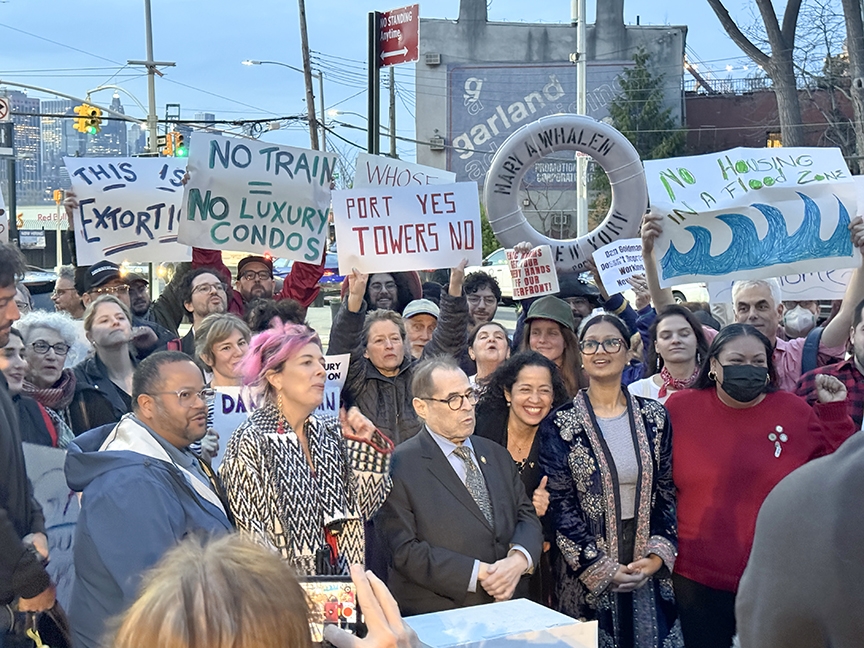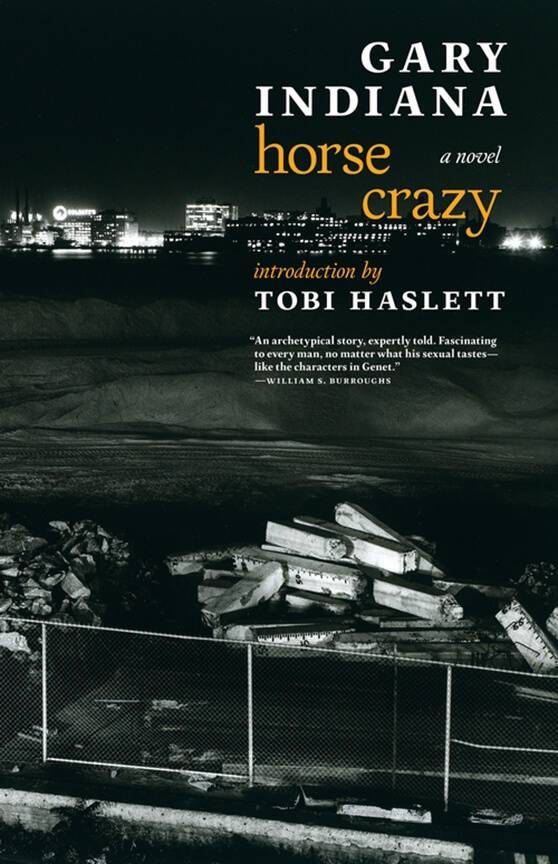Gowanus’s upcoming rezoning will likely make much of the neighborhood’s old industrial infrastructure eligible for redevelopment as residential high-rises. According to the Gowanus Landmarking Coalition, a local advocacy group formed in 2017, if the New York City Landmarks Preservation Commission (LPC) doesn’t step in to protect key sites from demolition, Gowanus’s built environment will cease to embody the rich history of the neighborhood.
On the first weekend in May, around the birthday of the writer and activist Jane Jacobs (1916-2006), the nonprofit Municipal Art Society organizes Jane’s Walk NYC, an annual festival of free guided tours inspired by Jacobs’s granular, grassroots approach to urban planning. Gowanus Landmarking Coalition member Brad Vogel used the occasion to lead a group of about 20 from Union Street to Butler Street on a rainy Sunday, showcasing a piece of Brooklyn that might soon disappear.
“It’s a really interesting place because so much of it is untouched from the 19th and early 20th century,” Vogel described. “Why? Because of the pollution, because of the crime, because of various things that have kept redevelopment or gentrification at bay for a long, long time. Even the geography – it floods. This is really low land.”
Vogel referred to the tony heights of “Brownstone Brooklyn” as a “horseshoe” surrounding Gowanus. “We are down in the middle of the horseshoe. And what happens down in the middle of the horseshoe? That’s where you put all the bad stuff, just push it down the hill. You keep your nice house up on the hill, and you put all the toxic manufacturing down here. You put all the horses down here. You put anything that’s sort of less than pleasant down in Gowanus.”
The challenge, for Vogel, is to persuade the LPC to regard the “less-than-pleasant” stuff of Gowanus’s working-class history as worthy of protection. The agency’s criteria demand “a special character or special historical or aesthetic interest or value as part of the development, heritage, or cultural characteristics of the City, state, or nation.”
The Coalition has suggested 15 sites in Gowanus for preservation, including the first stop of Vogel’s tour: the Union Street Bridge Control Tower, which operates the still-functional but rarely opened double-leaf bascule bridge that forms the Gowanus Canal’s northernmost crossing. Vogel mentioned that the city had already sought once in recent memory to replace the bascule bridge with a fixed bridge, which would render the control tower disposable.
At the time, the Gowanus Dredgers Canoe Club, where Vogel serves as captain, pointed out that the EPA’s Superfund cleanup would require heavy equipment entering the polluted canal by barge, and a fixed bridge would block its entrance. The city decided to put off the new bridge idea until the end of the cleanup. After that, the bascule bridge and its control tower, the youngest site on the Coalition’s list, will likely reappear on the city’s chopping block. Vogel praised the tower’s Mid-Century Modern style and its “lovely pistachio-colored glazed tile.”
“Some people in the LPC would probably say this is ‘too utilitarian,’” he lamented. “However, that’s one thing the Gowanus Coalition is really working on, saying to the LPC, ‘Look, in Gowanus, there are a lot of buildings that are important to this place that might not look like a pristine architectural gem from the Upper East Side or the West Village, but they mean a lot to us, and we think you need to have a more expansive sense of what is a landmark.’”
Subsequently, the group visited the former National Packing Box Company (circa 1910) at 543 Union Street, which after a fire in 1932 switched its production from boxes to brass and cabinetry; the Gowanus Station (circa 1913) at 234 Butler Street, a city property sold to a sanitation repair company in 1978; and the R.G. Dun and Company Building (circa 1914) at 206 Nevins Street, an old printing facility that began to manufacture plastics in the 1960s.
Vogel acknowledged the visible “accretion of changes as the building[s] adapted to different uses.” This can be a problem for the LPC, which tends to prefer structures that represent pure, unaltered examples of the architectural periods that birthed them. But as Vogel sees it, “in Gowanus, part of the story is the changes and the accumulation of different things over time. That’s part of what makes interesting history in this neighborhood.”
Some of the abovementioned sites may continue to stand, at least in some form, after the rezoning. In a deal with the EPA regarding the Gowanus Station, which the city reacquired via eminent domain last year, the New York City Department of Environmental Preservation agreed to dismantle the structure carefully enough to allow for the reconstruction of its Beaux-Arts façade after the installation of a Combined Sewage Overflow tank or tunnel beneath the property.
Vogel also reported that the owner of R.G. Dun and Company plant will make use of federal tax credits for the restoration of historic structures to convert the building’s interior into offices. But for many of the other disused factories in the area, nothing stands in the way of demolition, since the LPC has so far designated only two official landmarks in Gowanus: the Carroll Street Bridge and the Coignet Stone Building at 360 3rd Avenue, next to Whole Foods.
According to Vogel, in a face-to-face meeting, the Coalition asked Gowanus’s councilman, Brad Lander, to write a letter to the LPC to request consideration for their 15 proposed additional landmarks, but Lander refused on account of an unwillingness to work with the Coalition members from FROGG (Friends and Residents of Greater Gowanus), a supposedly antidevelopment group that he’d deemed toxic. Parts of Gowanus belong to Council Member Stephen Levin’s district, but Levin has largely deferred to Lander on issues related to the rezoning.

Vogel’s tour ended at the ASPCA Memorial Building at 233 Butler Street. The American Society for the Prevention of Cruelty to Animals constructed its Brooklyn headquarters in Gowanus in 1913 to care for the neighborhood’s horses, since the area had many stables, and a large concrete trough, built into the sidewalk, still fronts the building, which now houses the music venue Public Records.
Vogel complimented the structure’s “neo-Romanesque arches and all the little brickwork arcades up top” and doubted whether the new buildings in Gowanus would be as attractive. “I do feel like we have a problem right now that buildings are being built in the most generic way possible. Part of what the exterior of a building does is in a city is it gives something back to the community, and right now, buildings are being built that aren’t cognizant of that. It’s all about the view from the inside, and it doesn’t really matter what anyone else thinks. In the past, there was much more of this give-and-take.”










